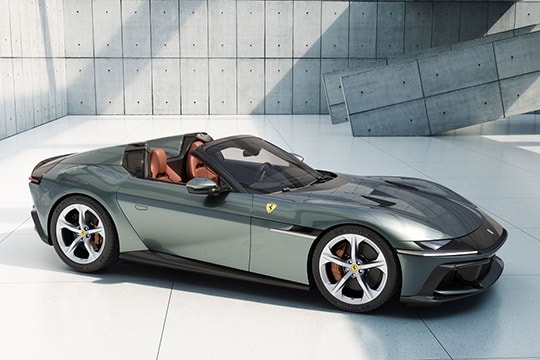FERRARI 12Cilindri Spider Models/Series Timeline, Specifications & Photos
First production year: 2024
Engines: Gasoline
Body style: Convertible (spider/spyder, cabrio/cabriolet, drop/open/soft top)
Ferrari introduced the 2024 12Cilindri Spider at the same time as the coupe sibling of this moniker, creating a perfect duo of naturally aspirated supercars that replaced the 812 Superfast in the carmaker’s lineup.
The Italian automaker didn’t earn its reputation because it followed the rules and trends. It gained its aura thanks to its customer-oriented thinking and the high-performance models it created even during challenging economic times. Ferrari knew its customers well and understood their passion for naturally aspirated V12 engines. As a result, it made the 12Cilindri (12 Cylinders) lineup, consisting of a coupe and a roadster, the latter being traditionally called the 12Cilindri Spider. Surprisingly, even though it had the technology to create a mild-hybrid vehicle, the automaker denied all these electrified aids and launched an ICE-only supercar. But, as Gianmaria Fulgenzi, chief of the product development of the 12Cilindri, stated, it was not a V12; it was “the V12,” suggesting that it was the epitome of the twelve-cylinder engines, at least in Ferrari’s inventory. For the Spider version, the development program was made in parallel with the berlinetta version, so the automaker didn’t have to struggle to find a new solution to cut the roof of the hard-top version to create an open-top one.
Its front fascia resembled the open-top grand tourer vehicles developed by Ferrari in the ‘50s and ‘60s. Customers could easily recognize the design language of the famous Daytona model, albeit the version with fixed headlights. But despite the inspiration taken from the old models, the technology included was new. As a result, the 12Cilindri Spider boasted LED headlights and daytime running lights, the latter resembling the chromed corner-mounted bumper of its illustrious predecessor.
With a profile that left no doubt about the car’s heritage, the 12Cilindri impressed with the low-slung greenhouse and the flared wheel arches that revealed a muscular shape. In addition, a pair of vents on the hood extracted hot air to help cool the massive powerplant. At the same time, a set of grilles adorned the front fenders and released the air trapped inside the wheel wells. While both vehicles shared the same panels up to the A-pillars, the Spider featured a retractable folding roof that could be raised or lowered in 14 seconds at speeds of up to 25 mph (40 kph). When retracted, it exposed the two humps behind each of the two occupants, where safety arches were concealed. Furthermore, the design resembled those of famous Ferrari racing cars from the past.
Inside, the automaker offered customers an option for three kinds of seats, with mild or high bolstered areas, with carbon fiber shells or not. Fronting the driver was a binnacle with a configurable 15.6-inch display inside it. At the same time, in front of the passenger side, there was an additional 8.8-inch touchscreen, which could be configured. The automaker placed a 10.25-inch touchscreen atop the center console for the infotainment system that supported Apple CarPlay and Android Auto. Due to the retractable hard top, the trunk was smaller than the one offered by its coupe sibling, albeit it was large enough for a weekend escape.
However, the real magic happened under the car’s skin. The engine was mounted up front but in a rearward position for better weight distribution. An eight-speed automatic (dual-clutch) transaxle gearbox sent all the power to the rear wheels. The 6.5-liter V12 powerplant was developed with some help from the Ferrari F1 team and developed a massive 630 PS (819 hp).
